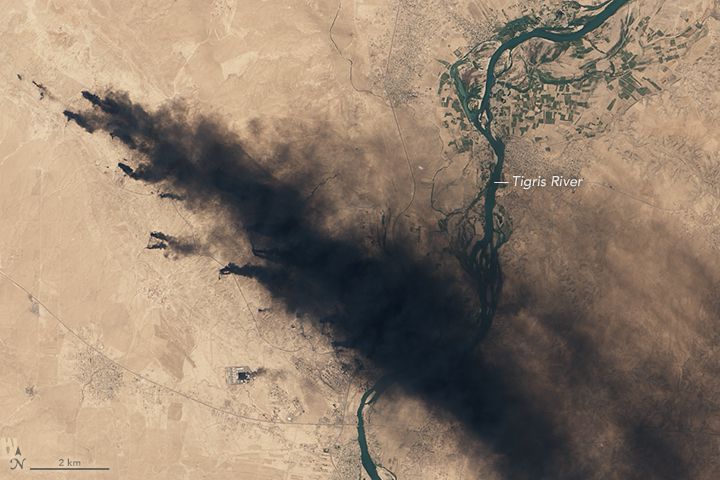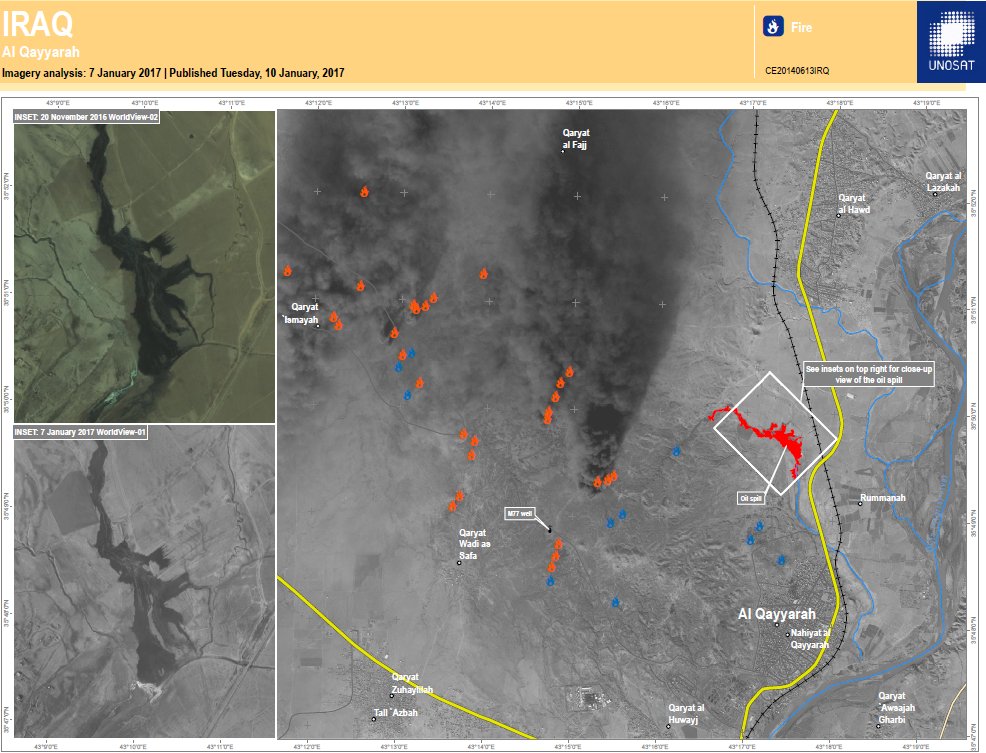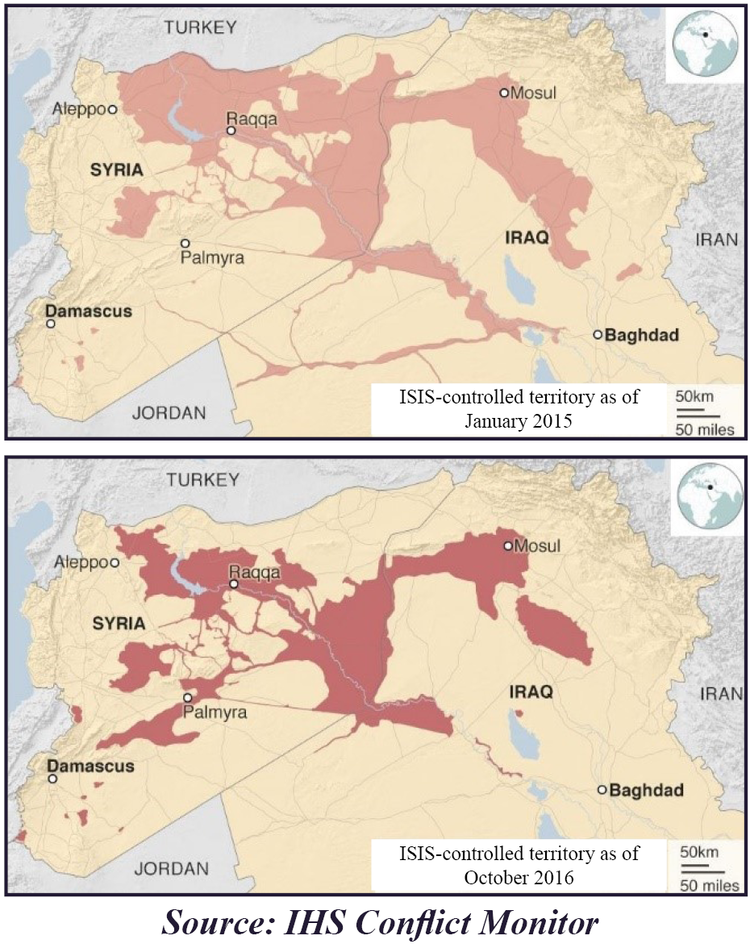
| ICE Case Studies
|
|
I.
Case Background |

As the ISIS "caliphate" dramatically shrank in 2017, it resorted to increasingly desparate methods to maintain control of territory. Some measures used the environment in ways they hoped would slow down or hinder the advance of the Iraqi army and the related para-militaries. This case study focuses on two such uses. First, it looks at the burning of sulfur from nines around Mosul to provide cover and to poison advance soldiers. Second, like Saddam Hussein in the first Gulf War in 1990, they burned oil wells for the same reasons. The military usefulness of these measures were very limited and for the most part ineffective and annoyances at best. However, the environmental impacts of these actions will be much more long-lsating.
Mosul was the largest city captured by ISIS and the center of its operations in Iraq. The battle to take it back by Iraqi forces, Shiite paramilitaries, and support from the United States and other countries, took place in 2017. ISIS fighters used many unconventional tactics such as female suicide attackers and suicide bombers driving explosive-laden armored vehicles.
In Iraq, the environment itself has once again become a weapon of war. Larry Karlis reported that there were three ways in which ISIS used the environment to wage war: first, starting large-scale industrial fires, second bruning oil fields, and third, igniting sulfur mines and sulfur plants." (Karlis, 2016) All three meant to foul the air for combatants and non-combatants and to make air strikes more difficult.
Karlis points to satellite "imagery from the past week [that] reveals front-line fires near the city as well as two large industrial fires that were set off by the Islamic State as the militants retreated from those positions."(Karliss, 2016) Some of this effluent is from the burning of industrial facilities. Much of the smoke is from the burning of oil wells. "The black smoke is from the Qayyarah oil field, which burned for over four months." (Karliss, 2016) It also had the benefit (to ISIS) in rendering, in the short-term, the usability of the resource. In the end, at least 15 oil wells were lit on fire.
Figure 1:
Crude oil runs through the streets of Qayyarah, Iraq, on 28 August 2016. (UNICEF)

The industrial fires were directed at the enemy troops, thinking it would debilitate them during the fight, but it turned out only to be an annoyance that could be combatted with a simple scarf. Civilians naturally bore the brunt of the health impacts. Chemical planys were chosen. "The white smoke that begins on Oct. 20 is from a sulphur plant in Mishraq that was retaken by Iraqi forces within days of the start of the operation." (Plumer and Dreazen, 2016). A sulfur mine was also burned.
Some environmental damage was almost comical if not a war crime. "Then, on August 28, as Iraqi forces entered Qayyarah, ISIS reportedly opened up oil pipes in the town and flooded the streets with crude. UNICEF arrived the next day and found oil spilling into the Tigris River — the town’s main source of drinking water." (Plumer and Dreazen, 2016). Did they rally believe tht the oil would make the combat environment slippery enough to slow the advance? The residents will be left to deal with the problem.
In some cases, ISIS followed the failed playbook of Saddam Hussein in 1991. "That wasn’t the end of it. In October, as Iraqi forces pushed toward Mosul, ISIS fighters reportedly began filling trenches with crude oil and set them on fire to make it harder for American and Iraqi warplanes, drones, and attack helicopters to find and hit targets inside the city."
In the end, one has to wonder whether there was a serious battlefield strategy or whether it was an attempt to create a small-scale Armageddon which reflects part of their "end of days" ideological tenet.
https://isis.liveuamap.com/en/2017/11-january-new-analysis-by-unosat-shows-environmental-damage
Figure 2:
New analysis by @UNOSAT shows environmental damage of oil fires in Qayyarah, with 9 wells still burning,
January 7, 2017.



Oil wells set on fire by ISIS leave thousands of Iraqi families suffering beneath skies of black smoke. (Oxfam, 2016.)
"The fires started in August when ISIS, retreating from the town of Qayarrah, about 80 kilometers from Mosul, rigged 15 well heads with explosives and then set them ablaze by shooting at them from nearby buildings. Families watched as the wells exploded, spewing oil into the air and splashing it onto their homes. Locals estimate that the fires burned as many as 60 homes, while many more were left uninhabitable because of the oil bubbling in and around them."
Some fires were set in summer 2016 and burned for many months, even long after the defeat of ISIS. The last fires were not extinguished until April, 2017. These fires were set to the east of Mosul and meant to slow the advancing forces.
If you regard the "caliphate" as a state of some sorts this can be called an international conflict. It also has clear internal relations.
The impact of the environmental war by ISIS was not effective, although two civilians died and maybe 100 were hospitalized. No doubt there will be long-term consequences as well. Overall casualties in the war will be much higher, especially among civilians.
The number of ISIS fighters may never have exceeded 50,000 at any one point with very high attrition rates. However, the violence against civilians far out-paced the military in terms of deaths.

The use of environmental resources as a weapon of war is something that is very old to the Middle East. Many thousands of years ago the Sumerians used water as a weapon. The Romans salted the wells of Carthage to prevent the citzens from returning to their homes after their war had concluded.
From a maximum extent in 2014-2015, the territorial control of ISIS has shrunk dramatically in 2016. In December 12017, the Iraqis pushed ISIS out of Iraq and Russian President Putin announced the withdrawal of some Russian air forces in Syria, where ISIS is also under heavy pressure. ISIS now only controls a few pockets of territory.
Figure 3
IHS Conflict Monitor


Sumer Use of Water in War Case
Go to Ice Search Engine and Scenario Builder
Laris Karklis, "How the Islamic State is using scorched earth tactics as it retreats", Washington Post , Updated Oct. 25, 2016
Brad Plumer and Yochi Dreazen Nov 1, 2016, 12:19pm EDT Vox, https://www.vox.com/2016/11/1/13481682/isis-mosul-oil-fires-sulfur
Oxfam November 4, 2016
